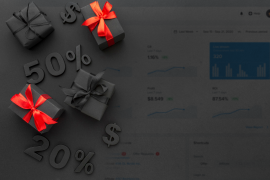Today, we are going to break the B2B buyer journey into parts. Understanding how the buyer comes and how he comes back to you, is crucial if you want to successfully implement lead generation in your target audience. As we all know that the B2B industry is a few miles behind B2C, when it comes to online marketing.
Table of contents
- All Roads Lead to Google
- Taking the first step in the customer journey
- Reduce complexity through personalization
- The B2B buyer journey in 7 steps
- 1 – Out-of-the-market
- 2 – Trigger
- 3 – Brand consideration
- 4 – Active evaluation
- 5 – Purchase decision
- 6 – Experience
- 7 – Loyalty
- From warm lead to a hot lead
- Conclusion – the B2B buyer journey
Just like in B2C, decisions for a new purchase or supplier are made by people in the B2B sector. And they search online. The big difference regarding B2C, however, lies in the number of people involved in the decision.
In B2B, different stakeholders with different disciplines (and interests) often work together in a DMU, a decision-making unit.
B2B lead generation is different.

Oddly enough, the behavior that these decision-makers display in the orientation process does not differ much from consumer behavior.
The fact that the B2B industry is lagging behind in online marketing is, therefore, a shame, because potential customers have developed an increasingly strong desire to orient themselves online in recent years.
All Roads Lead to Google
Several studies have been conducted on the changing buying behavior within B2B. The consensus is that more than 90% of purchases are online-oriented, and that process begins – (yes, you guessed it!) in 70% of the cases with a general Google search.
Before a B2B company has identified the solution to a specific problem, knowledge is often sought on the internet. The website visitor introduces himself/herself to a subject but is not yet looking for a solution, supplier, or purchase. In fact, the main problem may not even be known yet.
Even in this preliminary phase of the customer journey, you can already catch your potential lead’s attention.
SEO-optimized content (for example, with a blog or knowledge base on your own website) allows you to make the first acquaintance with the potential B2B lead. And with that, the first chance to present yourself as an authority in your market.
As you can guess, you will have to research your target groups to find out which problems and issues your services and products can be used to solve.
Taking the first step in the customer journey
When someone interacts with your content for the first time, you shouldn’t expect to have a lead in your pocket right away.
However, the first baby-step in the customer journey has been taken forward.
Typically B2B buyers ask potential suppliers to…
The right question would then be: what is the next step that a potential lead would like to take? In other words: what information does he or she need?
There are opportunities for B2B companies to be noticeable in this first introduction process. But, how do you ensure that your online channels differ from those of the competitor?
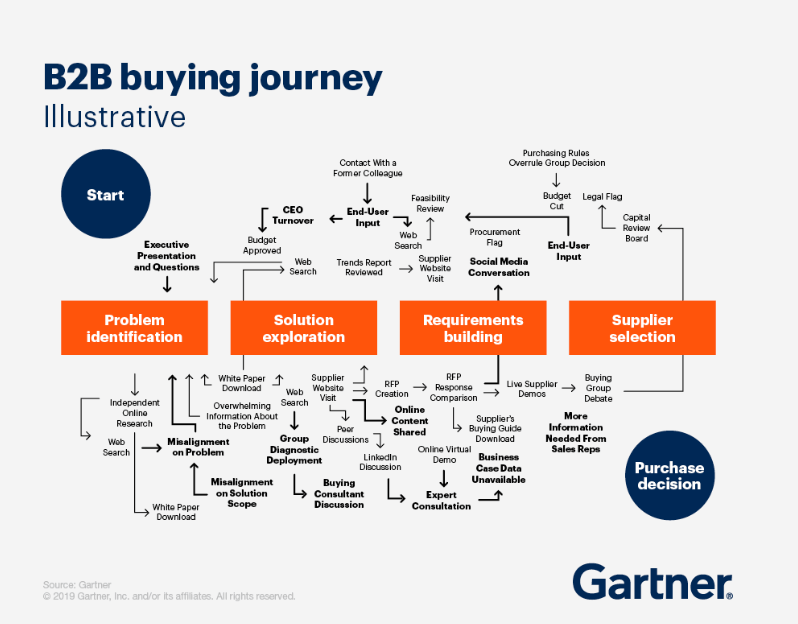
Reduce complexity through personalization
77% of decision-makers within a DMU found the latest purchase complex. Due to an abundance of information and content, it is often difficult to determine the best solution for a specific issue.
As a result, “online orientation” quickly becomes a struggle for many B2B target groups.
At Scaleo, we sometimes deploy a CDP (Customer Data Platform) ourselves so that the website visitors can see personalized content. For example, you can show a visitor from the financial services sector different content than to a visitor who is active in the transport industry. This is achieved by bundling data from CRM systems, email marketing, advertising, and other sources into one intelligent platform. In term, this makes personalization possible.
After all, the ideal customer journey is personal and can mean something entirely different for different visitors.
If you bundle good timing with high relevance, miracles can happen!
The B2B buyer journey in 7 steps
In our practice, the B2B customer journey (simplified) consists of 7 phases.
Not linear, but in a circle.
The idea is, you want the customer to come back to you (after he searched around). Being actively present where potential and existing customers hustle is, therefore, the key to success.
Traditionally, the distribution between sales and marketing in the buyer journey has been the same. Still, we have seen that in recent years it has shifted towards a larger share of marketing.
Without further ado, let’s explore the 7 steps the B2B buyer journey.
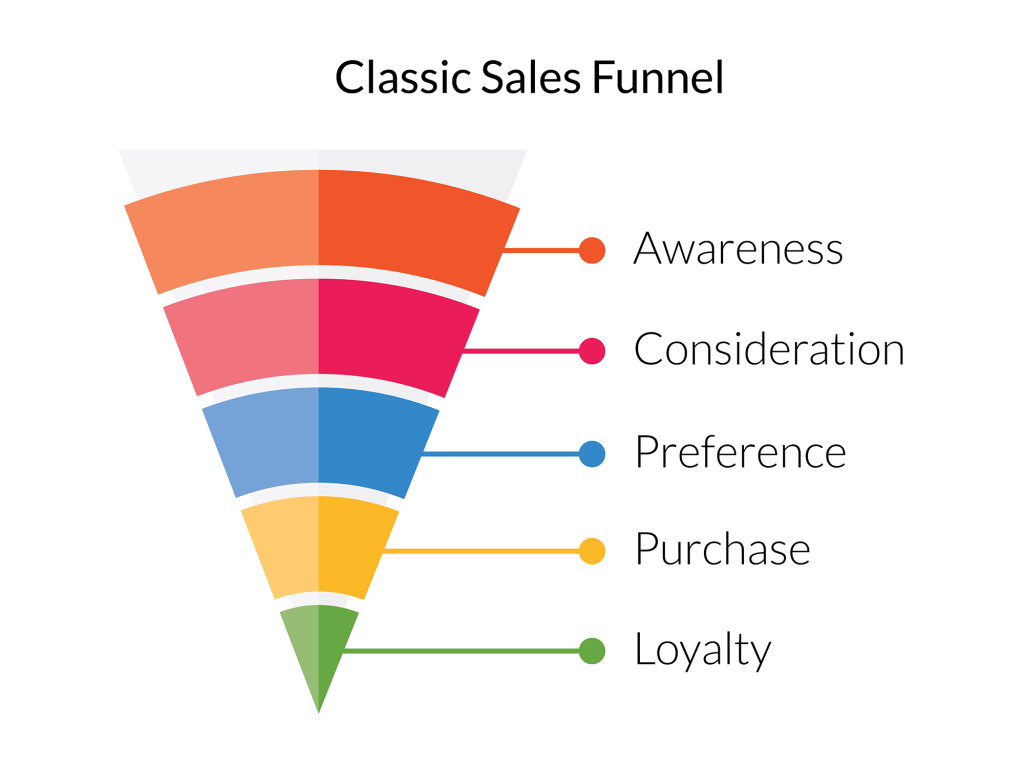
1 – Out-of-the-market
The potential lead reads thought leadership content, keeps an eye on industry-specific trends via social media (for example, via LinkedIn and Medium), and is looking for inspiration from various angles. In this “out of the market” phase of the buyer journey, the potential lead is not yet fully aware of the problem or solution. You can also see this phase as the pre-awareness phase.
2 – Trigger
A problem has been identified in the potential lead’s company, which is why we are actively looking for various suitable solutions. A project group is often put together to find the right solution so that all the stakeholders can contribute their input. These stakeholders proactively use Google Search, niche blogs, videos, and other content to gain more insight into the topic.
3 – Brand consideration
The potential lead (DMU) has found a suitable solution and lists potential suppliers. In this phase, they visit websites of suppliers and comparison websites (for example, such as G2 for software), and gather reviews and experiences.
During this phase, “potential” lead changes to an “actual” lead.
4 – Active evaluation
During the “active evaluation” phase, stakeholders look for additional value, expertise, and trust from potential suppliers.
Think of white papers about specific topics (solutions), case studies, or a demo of a product or the working method. Sometimes they contact the sales department during this phase, but this is mainly in the form of a demo request.
The list of potential suppliers or service providers is trimmed down to a small list of likely candidates.
5 – Purchase decision
The stakeholders put their heads together to select a supplier from the small list that has remained. In this phase, there is often only actual contact with a salesperson.
Sometimes, various proof of compatibility/service is requested before the ultimate supplier is selected. However, once this is done, the team’s solution is approved, and an agreement is signed.
The buyer journey is complete – now, the customer journey begins. (Check out also Starbucks marketing strategy to learn from this case study.)
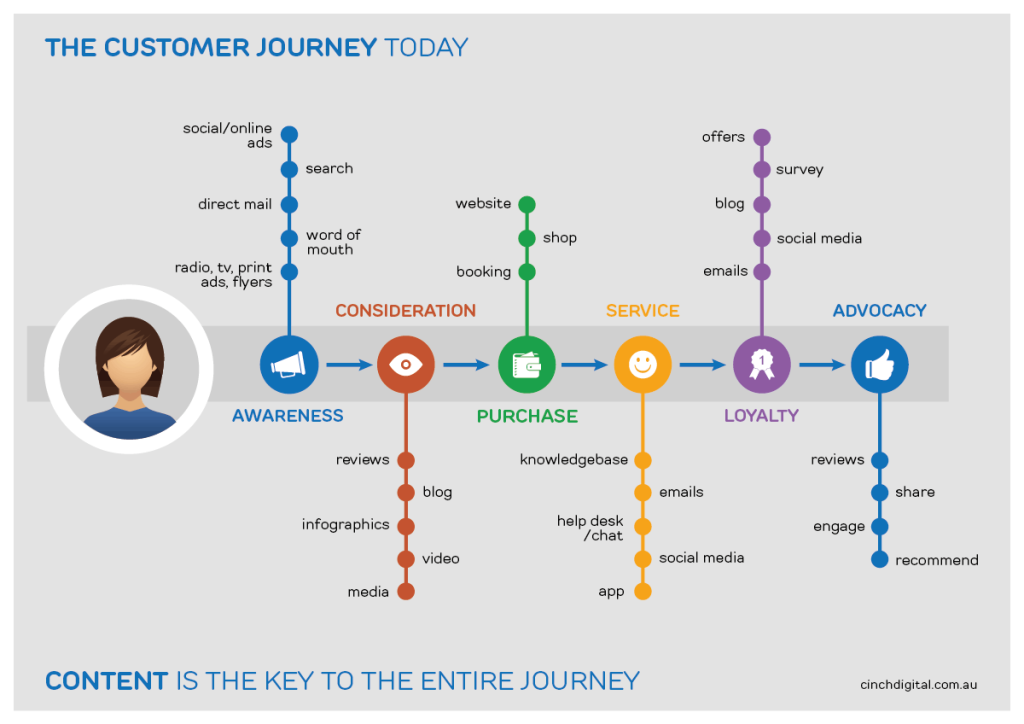
6 – Experience
As I have already mentioned, the ideal customer journey is not linear but instead – goes in a circle. If a customer’s experience with your products and services is positive, the opportunity emerges for repeat purchases or upsell in the loyalty phase.
User-friendliness and clarity are of supreme importance.
For the user experience itself, you can think of:
- A clear starting point.
- Reliable support.
- Planning: proper implementation and a smoothly running process.
- The actual product or service you provide lives up to the quality expectations.
7 – Loyalty
The customer experience is generally great during the initial (“honeymoon”) phase of the partnership but should remain smooth throughout the customer journey.
“Retention” is the key-word for long-term success, and the best thing to do is to remember why your customers partnered with you in the first place.
Show them that you care even after the purchase is made.
Regularly inform them about new features you offer with your platform, or a new way of working that you use to increase customer satisfaction.
Send them emails with useful content to help them get even more out of their purchase. Build a roadmap for the coming year, so that your customer can see what your team is planning to provide soon.
Ask yourself the question: what would I want to know and see if I was in the customer’s shoes?
Remember: a happy and loyal customer is a customer who recommends you to others.
It is also easier to sell something to an existing customer (upsell or offer a new product) than to bring a new customer in.
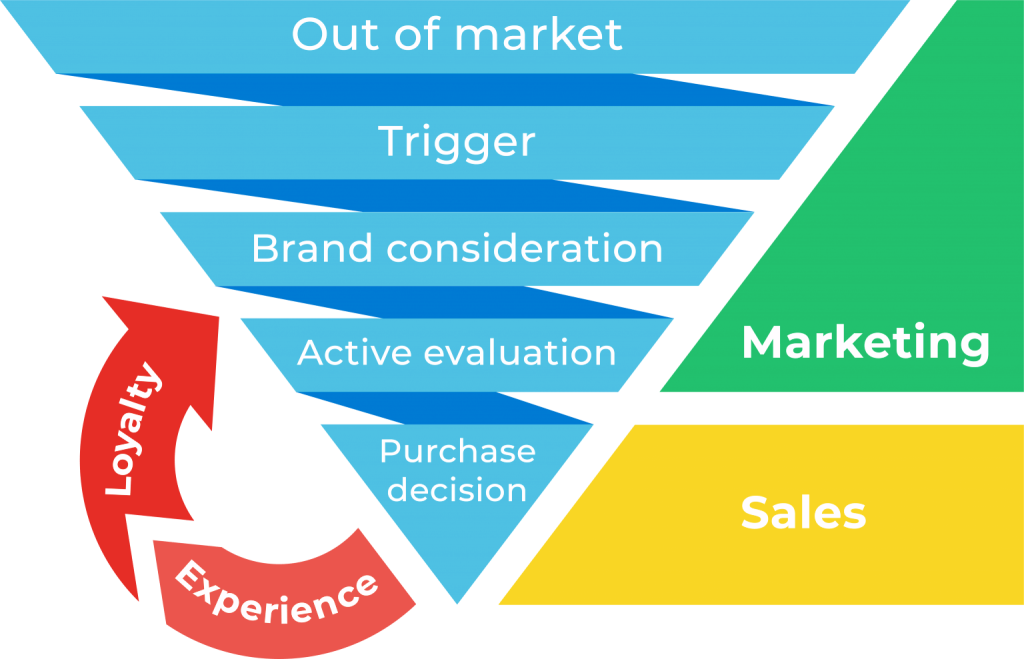
From warm lead to a hot lead
Depending on your situation and the type of business you work in, there are different options. Sometimes sales agents already act earlier in the buyer journey, but in many cases, it is mainly the marketers who turn a potential (let’s call it a “warm lead”) to a real hot lead.
As a marketer, when you begin to see a “light at the end of the tunnel,” you naturally ask yourself: when do you transfer a lead to the sales department?
However, a better question is: when is someone ready to contact sales?
Determining how “warm” a lead can be achieved with ‘lead scoring” With this, you set up certain conditions based on the formulated 7-step buyer journey, making it easier to understand where a potential lead stands.
For example, it can be tracked how much (and what) information a potential lead takes in and whether there is interaction with your social media channels. Is there a possibility, for example, to collect an email address from the potential lead? And does the lead then respond to the emails you send? A simple idea, but a response (or none), is a good indicator of whether someone is ready to contact the sales department.
Many tools are available to implementing b2b lead generation, perhaps your current CRM system already offers possibilities for it, but you never used it.
Conclusion – the B2B buyer journey
Accurately drawing up the B2B buyer journey ultimately leads to more sales. It is crucial to collect insight into your target groups and make different buyer journey phases measurable.
What does the visitor on your website do? From which channels do visitors come, and how often do they complete the right actions on your website – and what content and information do they consume? How is that consistent with the steps in the buyer journey – and what is the next step that a potential lead wants to take? This all can be tracked with CPA tracking software. Read more about CPA tracking software on our blog post.
Making everything you create measurable is a precondition for calculating and obtaining expected success.
Last Updated on January 5, 2021


